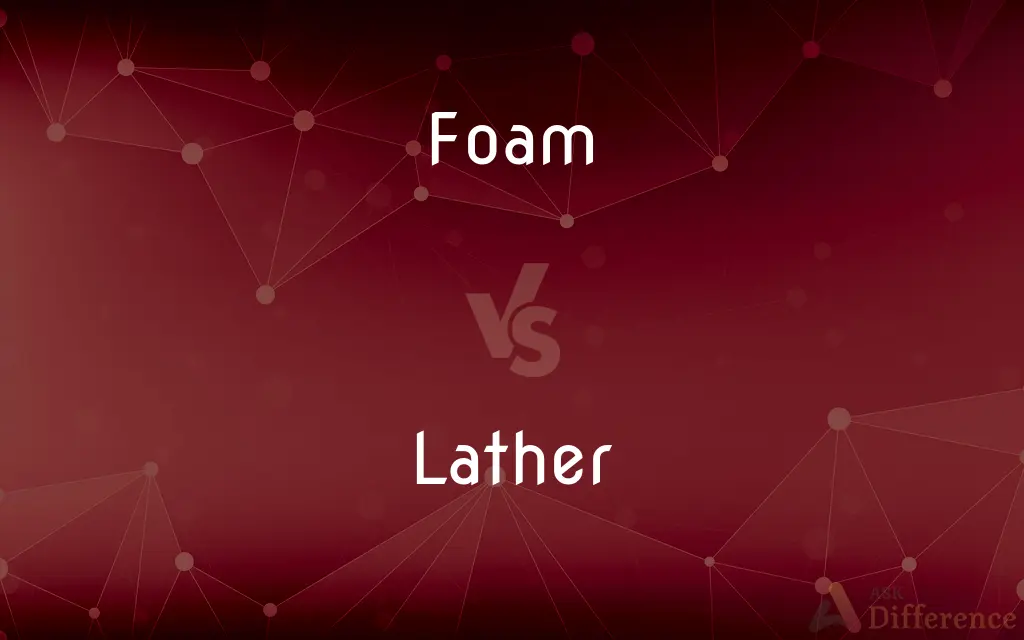Foam vs. Lather — What's the Difference?
By Fiza Rafique & Maham Liaqat — Updated on March 20, 2024
Foam is a mass of small bubbles formed in or on a liquid, seen in beverages or chemical reactions, while lather is specifically the frothy substance from soap and water, primarily used for cleaning.

Difference Between Foam and Lather
Table of Contents
ADVERTISEMENT
Key Differences
Foam is created when gas bubbles are trapped in a liquid or solid, which can occur naturally or through agitation. It's common in various contexts, from culinary arts to industrial processes. Whereas lather specifically refers to the frothy mix of soap and water, with its primary use being cleaning and personal hygiene.
Foam can be found in many natural and man-made scenarios, such as frothy sea waves, beer heads, and foam insulation. It's valued for its unique properties, such as insulation and cushioning. On the other hand, lather is often associated with the action of cleansing, whether it's washing hands, bathing, or shaving, highlighting its role in hygiene and personal care.
The stability and structure of foam depend on the liquid's properties and the gas volume it contains, making it variable in texture and longevity. In contrast, lather is typically more uniform, with its quality depending on the soap's formulation and the agitation method, aiming for a balance between richness and rinsability.
Foam's applications extend beyond everyday products to include fire-fighting foams and foamed plastics, showcasing its versatility across different industries. Lather, however, is mainly found in beauty and cleaning products, signifying its specialized role in sanitation and skincare.
Despite their differences, both foam and lather are significant in their respective domains, demonstrating how simple changes in context and composition can lead to distinct uses and characteristics.
ADVERTISEMENT
Comparison Chart
Definition
A mass of small bubbles formed in or on a liquid or solid.
A frothy substance made by agitating soap and water.
Primary Use
Insulation, cushioning, or as a product feature (e.g., in beverages).
Cleaning and personal hygiene.
Formation
Can be formed by natural processes or artificially, in various substances.
Specifically formed from soap and water through agitation.
Texture and Stability
Variable, depending on the medium and gas content.
More uniform, depends on the soap's formulation and agitation method.
Applications
Diverse, ranging from culinary arts to industrial uses.
Primarily in personal care and cleaning products.
Compare with Definitions
Foam
A material used for insulation or padding.
The foam in the mattress provides excellent support.
Lather
A symbol of cleanliness or the act of cleaning.
A good lather is key to a close and comfortable shave.
Foam
Froth formed by the agitation of liquids.
The foam at the sea's edge looked almost magical at dawn.
Lather
Indicates thoroughness in washing.
Lather your hands well to ensure they are clean.
Foam
A lightweight form used in various industries.
Structural foam panels are essential in construction for their insulation properties.
Lather
A term often associated with barbers and personal grooming.
The barber applied a warm lather before starting the shave.
Foam
A collection of small bubbles, often seen in drinks.
The foam on top of the cappuccino was perfectly creamy.
Lather
The frothy substance produced by soap and water.
She worked the soap into a rich lather before applying it.
Foam
A product of chemical reactions.
The reaction between vinegar and baking soda created a lot of foam.
Lather
Used in various personal care products.
The body wash creates a luxurious lather that moisturizes the skin.
Foam
Foam is an object formed by trapping pockets of gas in a liquid or solid.A bath sponge and the head on a glass of beer are examples of foams. In most foams, the volume of gas is large, with thin films of liquid or solid separating the regions of gas.
Lather
A foam formed by soap or detergent agitated in water, as in washing or shaving.
Foam
A mass of small bubbles formed on or in liquid, typically by agitation or fermentation
A beer with a thick head of foam
Lather
Froth formed by profuse sweating, as on a horse.
Foam
Form or produce a mass of small bubbles; froth
The sea foamed beneath them
Lather
(Informal) A condition of anxious or heated discomposure; agitation
The students were in a lather over the proposed restrictions.
Foam
A colloidal dispersion of a gas in a liquid or solid medium, such as shaving cream, foam rubber, or a substance used to fight fires. A foam may be produced, especially on the surface of a liquid, by agitation or by a chemical reaction, such as fermentation.
Lather
To spread with or as if with lather.
Foam
Any of various light, porous, semirigid or spongy materials, usually the solidified form of a liquid full of gas bubbles, used as a building material or for thermal insulation or shock absorption, as in packaging.
Lather
(Informal) To give a beating to; whip.
Foam
Frothy saliva produced especially as a result of physical exertion or a pathological condition.
Lather
To produce lather; foam.
Foam
The frothy sweat of a horse or other equine animal.
Lather
To become coated with lather.
Foam
The sea.
Lather
The foam made by rapidly stirring soap and water.
Foam
To produce or issue as foam; froth.
Lather
Foam from profuse sweating, as of a horse.
Foam
To produce foam from the mouth, as from exertion or a pathological condition.
Lather
(countable) A state of agitation.
Foam
To be extremely angry; rage
Was foaming over the disastrous budget cuts.
Lather
(transitive) To beat or whip.
Foam
To teem; seethe
A playground foaming with third graders.
Lather
(intransitive) To form lather or froth, as a horse does when profusely sweating.
Foam
To cause to produce foam.
Lather
Foam or froth made by soap moistened with water.
Foam
To cause to become foam.
Lather
Foam from profuse sweating, as of a horse.
Foam
A substance composed of a large collection of bubbles or their solidified remains, especially:
Lather
To spread over with lather; as, to lather the face.
Foam
A collection of small bubbles created when the surface of a body of water is moved by tides, wind, etc.
Lather
To form lather, or a froth like lather; to accumulate foam from profuse sweating, as a horse.
Foam
A collection of small bubbles formed from bodily fluids such as saliva or sweat.
Lather
To beat severely with a thong, strap, or the like; to flog.
Foam
A collection of small bubbles on the surface of a liquid that is heated, fermented or carbonated.
Lather
The froth produced by soaps or detergents
Foam
A collection of small bubbles created by mixing soap with water.
Lather
Agitation resulting from active worry;
Don't get in a stew
He's in a sweat about exams
Foam
(firefighting) A collection of small bubbles formed by mixing an extinguishing agent with water, used to cover and extinguish fires.
Lather
A workman who puts up laths
Foam
A material formed by trapping pockets of gas in a liquid or solid.
A foam mat can soften a hard seat.
Lather
The foam resulting from excessive sweating (as on a horse)
Foam
The sea.
He is in Europe, across the foam.
Lather
Cover with soap;
Lather your body when you shower
Foam
Fury.
Lather
Beat severely with a whip or rod;
The teacher often flogged the students
The children were severely trounced
Foam
(intransitive) To form or emit foam.
Lather
Form a lather;
The shaving cream lathered
Foam
(intransitive) To spew saliva as foam; to foam at the mouth.
Lather
Rub soap all over, usually with the purpose of cleaning
Foam
(firefighting) To coat or cover with foam.
It used to be common practice to foam the runway prior to an emergency landing, in case a fuel-fed fire occurred.
Foam
The white substance, consisting of an aggregation of bubbles, which is formed on the surface of liquids, or in the mouth of an animal, by violent agitation or fermentation; froth; spume; scum; as, the foam of the sea.
Foam
To gather foam; to froth; as, the billows foam.
He foameth, and gnasheth with his teeth.
Foam
To form foam, or become filled with foam; - said of a steam boiler when the water is unduly agitated and frothy, as because of chemical action.
Foam
To cause to foam; as, to foam the goblet; also (with out), to throw out with rage or violence, as foam.
Foam
A mass of small bubbles formed in or on a liquid
Foam
A lightweight material in cellular form; made by introducing gas bubbles during manufacture
Foam
Form bubbles;
The boiling soup was frothing
The river was foaming
Sparkling water
Common Curiosities
What is lather?
Lather is a frothy substance created by agitating soap and water, primarily used for cleaning and hygiene.
How is foam formed?
Foam can form naturally or through mechanical agitation, by trapping gas bubbles in a liquid or solid matrix.
Can lather form without water?
Typically, lather requires water and soap; without water, soap alone cannot create lather.
Is all foam created by soap?
No, foam can be created by many substances and processes, not just soap.
What is foam?
Foam is a mass of small bubbles formed in or on liquids or solids, seen in natural phenomena and man-made products.
What makes lather different from foam?
Lather specifically refers to the froth from soap and water, used for cleansing, whereas foam can refer to similar structures in various contexts.
Can foam be used for cleaning?
While foam can have cleaning properties, especially in products like foaming cleansers, "lather" more specifically denotes a product's cleaning ability.
What are the main uses of lather?
Lather is mainly used for cleaning, bathing, and personal grooming, providing a mechanism to lift and remove dirt and oils.
Are there environmentally friendly foams?
Yes, there are biodegradable and environmentally friendly foams made from natural sources.
How do industries use foam?
Industries use foam for insulation, packaging, cushioning, and in products requiring aeration, like bread and mattresses.
Do all soaps create the same amount of lather?
No, the amount and quality of lather depend on the soap's formulation and the hardness of the water.
Why is foam important in beverages?
In beverages, foam can enhance the sensory experience, affecting appearance, texture, and aroma.
Can lather be harmful?
If made from harsh chemicals, lather can potentially dry out or irritate the skin, though most personal care products aim to balance cleansing with skin health.
Is lather only used with traditional soap?
Lather can be produced with any cleansing agent capable of foaming, including modern synthetic detergents and natural soaps.
Is foam always considered a positive feature?
Not always; while foam can be desirable in certain products, it can be problematic in others, indicating contamination or unwanted chemical reactions.
Share Your Discovery

Previous Comparison
Elasticity vs. Ductility
Next Comparison
Semi vs. QuasiAuthor Spotlight
Written by
Fiza RafiqueFiza Rafique is a skilled content writer at AskDifference.com, where she meticulously refines and enhances written pieces. Drawing from her vast editorial expertise, Fiza ensures clarity, accuracy, and precision in every article. Passionate about language, she continually seeks to elevate the quality of content for readers worldwide.
Co-written by
Maham Liaqat














































